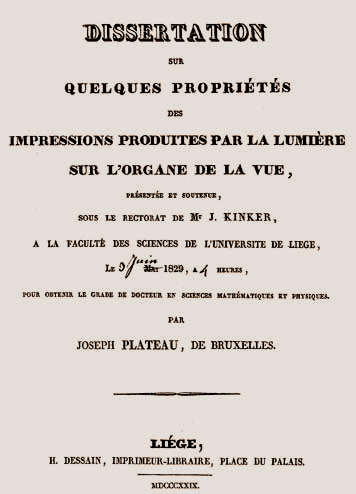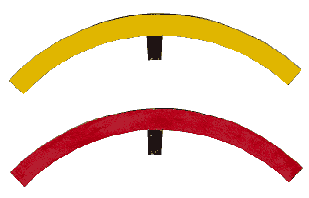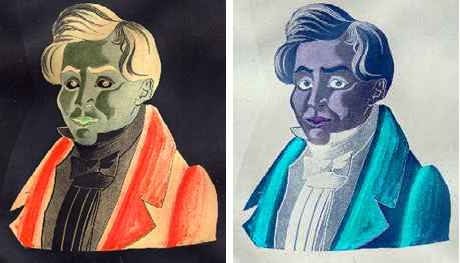On 12 march 1829 the doctoral thesis of Joseph Plateau is submitted to
Quetelet for advice. Although it contains only 27 pages, it formulates
a great number of fundamental conclusions. It contains the first results
of the research into the effect of colours on the retina (duration, intensity
and colour), the mathematical research into the intersections of revolving
curves (locus), the observation of the distortion of moving images, and
the reconstruction of distorted images (anorthoscopic discs).
1
 |
Doctoral
thesis of Joseph Plateau University library, Ghent The thesis "Dissertation sur quelques propriˇtˇs des impressions produites par la lumi¸re sur l'organe de la vue" is presented at the university on 9 June 1829. At the University of Li¸ge, the doctoral thesis of Joseph Plateau is the very first in physical and mathematical sciences to be written in French and not in Latin.
|
|
|
Visual persistence before Plateau's time
Aristotle (394 bC - 322 bC) is the first to describe how he sees a persistent image after looking into the sun, image that only slowly fades away. Leonardo da Vinci (1452 - 1519) also tackles the problem: an object that moves quickly colours its path with its own colour. Johannes Segner (1704 - 1777) observes (and he was not the first to do so) that one sees a red full circle when one moves a red-hot coal around in the dark, and does this at high enough speed. The revolving time offers a measure for the duration of the "impression". Segner estimates this to be 0.1s. The Chevalier Patrice d'Arcy (1725 - 1779) attaches a red-hot coal to a cross that is driven by a descending weight and turns around at a controlled speed. He estimates the persistence of the visual impression to be 1/7th or 0.15s. This value is dismissed by Plateau.
 |
Arcs
of a circle used by J.Plateau to study the persistence of an image. J.Plateau, Collection J.Plateau, Ghent The arcs are mounted on a black circular background. This is then revolved at increasing speeds. Starting from a certain angular velocity one observes a complete circle. |
| For his systematic study of the "persistence of light-impressions" (persistance des impressions lumineuses) and the observation and explanation of "accidental colours" (couleurs accidentelles). Plateau uses coloured arcs of circles, mounted on a black disc. From the experiments with these revolving discs, Plateau concludes: | |
| 1. a visual impression needs a certain time to form
and to disappear 2. impressions fade away slowly, and don't disappear suddenly 3. after the observation of a colour has taken place, it takes on average 0,34sec to completely disappear. 4. in the sequence white, yellow, red, blue the colours produce the most intense and durable impression |
|
Besides the duration of the impression, the thesis also describes research about the observation of so-called "accidental colours" (i.e. complementary colours) and their relationships. Plateau explains his observations as "persistence of the light-impressions". He links the persistence directly to the retina, a generally accepted view in the 19th century. In 1912 Max Wertheim (1880 - 1943) definitively establishes that the persistence of the image is linked to the brain (due to a perceptual construction the observer sees two successive stimuli received by the retina as a movement).
In 1830 health problems lead Plateau to resign as mathematics teacher at the "Atheneum" in Li¸ge. He moves to Brussels where he becomes a physics teacher at the Gaggia-Institute (1833 - 1834), a school of high reputation. Plateau often visits the Brussels Observatory, to talk to Quetelet about physics and to do demonstrations.
